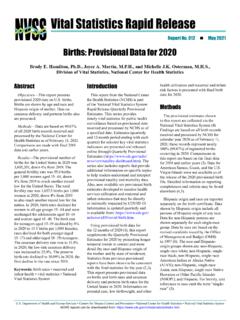Transcription of Vital Statistics Rapid Release - Centers for Disease ...
1 Vital Statistics Rapid ReleaseReport No. 010 February 2021 provisional Life Expectancy Estimates for January through June, 2020 Elizabeth Arias, , Betzaida Tejada-Vera, , and Farida Ahmad, Department of Health and Human Services Centers for Disease Control and Prevention National Center for Health Statistics National Vital Statistics System NCHS reports can be downloaded from: National Center for Health Statistics (NCHS) collects and disseminates the nation s official Vital Statistics through the National Vital Statistics System (NVSS). NCHS uses provisional Vital Statistics data for conducting public health surveillance and final data for producing annual national natality and mortality Statistics .
2 NCHS publishes annual and decennial national life tables based on final Vital Statistics . In order to assess the effects on life expectancy of excess mortality observed during 2020, NCHS is publishing, for the first time, life tables based on provisional Vital Statistics data. provisional data are early estimates based on death certificates received, processed, and coded but not finalized by NCHS. These estimates are considered provisional because death certificate information may later be revised and additional death certificates may be received until approximately 6 months after the end of the data report presents life expectancy estimates based on provisional death counts for the months January through June, 2020, by sex, for the total, Hispanic, non-Hispanic white, and non-Hispanic black populations.
3 Abridged period life tables calculated to produce the provisional life expectancy estimates are also provided via Internet tables (see Technical Notes and Internet tables 1 15). Life expectancy estimates based on final data for 2019 by sex, Hispanic origin, and race are also provided in this report for purposes of comparison (see Technical Notes and reference 1 for description of methodology). Keywords: life expectancy Hispanic origin race National Vital Statistics SystemData and MethodsProvisional life expectancy estimates were calculated using abridged period life tables based on provisional death counts for the first half of 2020 from death records received and processed by NCHS as of October 26, 2020; provisional numbers of births for the same period based on birth records received and processed by NCHS as of October 27, 2020; and, April 1, 2020 monthly postcensal population estimates based on the 2010 decennial census.
4 provisional mortality rates are typically computed using death data after a 3-month lag following date of death, as completeness and timeliness of provisional death data can vary by many factors, including cause of death, month of the year, and age of the decedent (2,3). Mortality data used in this report include over 99% of the deaths that occurred from January through June, 2020, but certain jurisdictions and age groups may be underrepresented for the latter months in the period (3). Deaths requiring investigation, including infant deaths, deaths from external injuries, and drug overdose deaths may be underestimated (4,5). See Technical Notes for more information about the calculation of the abridged period life tables and 2019 life expectancy estimates by race and Hispanic expectancy in the United StatesThe Table summarizes life expectancy by age, Hispanic origin, race, and sex.
5 Life expectancy at birth represents the average number of years that a group of infants would live if they were to experience throughout life the age-specific death rates prevailing during a specified period. In the first half of 2020, life expectancy at birth for the total population was years, declining by year from in 2019 (6). Life expectancy at birth for males was years in the first half of 2020, representing a decline of years from years in 2019. For females, life expectancy declined to years, decreasing year from years in 2019 (Figure 1). The difference in life expectancy between the sexes was years in the first half of 2020, increasing from in 2019. Between 2000 and 2010, the difference in life expectancy between the sexes narrowed from years to its lowest level of years and then gradually increasing to years in 2019 (Figure 1).
6 Life expectancy by Hispanic origin and raceBetween 2019 and the first half of 2020, life expectancy decreased years for the non-Hispanic black population ( to ) (Figure 2). It decreased by years for the Hispanic population ( to ) and by year for the non-Hispanic white population Department of Health and Human Services Centers for Disease Control and Prevention National Center for Health Statistics National Vital Statistics System2 Vital Statistics Surveillance Report070758085 FemaleMaleTotal2020201820162014201220102 0082006200420022000 Age (years)Figure 1. Life expectancy at birth, by sex: United States, 2000 2020 NOTES: Life expectancies for 2019 by Hispanic origin and race are not final estimates; see Technical Notes.
7 Estimates are based on provisional data from January 2020 through June : National Center for Health Statistics , National Vital Statistics System, Mortality data.( to ). In the first half of 2020, the Hispanic population had a life expectancy advantage of years over the non-Hispanic white population, declining from an advantage of years in 2019 (Figure 3). The Hispanic advantage relative to the non-Hispanic black population increased from to years between 2019 and the first half of 2020. The non-Hispanic white life expectancy advantage relative to the non-Hispanic black population increased from to years between 2019 and the first half of 2020. Among the six Hispanic origin and race-sex groups (Figure 4), the decrease in life expectancy between 2019 and the first half of 2020 was highest for non-Hispanic black males whose life expectancy declined by years ( to ), followed in order by Hispanic males with a decline of years ( to ), non-Hispanic black females with a decline of years ( to ), Hispanic females with a decline of years ( to ), non-Hispanic white males with a decline of year ( to ), and non-Hispanic white females with a decline of year ( to ).
8 Discussion and ConclusionsProvisional life expectancy at birth in the first half of 2020 was the lowest level since 2006 for both the total population ( years) and for males ( ), and was the lowest level since 2007 for females ( ). Life expectancy for the non-Hispanic black population, , declined the most, and was the lowest estimate seen since 2001 (for the black population regardless of Hispanic origin). The Hispanic population experienced the Table. Expectation of life by age, Hispanic origin, race for the non-Hispanic population, and sex: United States, 2020 All originsHispanic1 Non-Hispanic white1 Non-Hispanic black1 Age (years) tables by Hispanic origin are based on death rates that have been adjusted for race and ethnicity misclassification on death certificates.
9 Updated classification ratios were applied; see Technical : Estimates are based on provisional data from January 2020 through June 2020. provisional data are subject to change as additional data are : National Center for Health Statistics , National Vital Statistics System, Mortality, Department of Health and Human Services Centers for Disease Control and Prevention National Center for Health Statistics National Vital Statistics System3 Vital Statistics Surveillance blackNon-Hispanic whiteHispanicAge (years)20192020 Figure 2. Life expectancy at birth, by Hispanic origin and race: United States, 2019 and 2020 NOTES: Life expectancies for 2019 by Hispanic origin and race are not final estimates; see Technical Notes.
10 Estimates are based on provisional data from January 2020 through June : National Center for Health Statistics , National Vital Statistics System, Mortality (years)68 Non-Hispanic white andnon-Hispanic blackHispanic andnon-Hispanic whiteHispanic andnon-Hispanic 3. Differences between groups in life expectancy at birth: United States, 2019 and 2020 NOTES: Life expectancies for 2019 by Hispanic origin and race are not final estimates; see Technical Notes. Estimates are based on provisional data from January 2020 through June : National Center for Health Statistics , National Vital Statistics System, Mortality largest decline in life expectancy ( ) reaching a level lower than what it was in 2006, the first year for which life expectancy estimates by Hispanic origin were produced ( ).

















